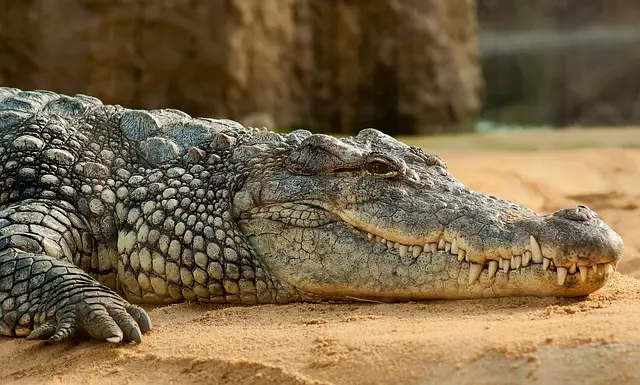There’s one animal you want to avoid encountering: the saltwater crocodile. These massive reptiles can grow up to 23 feet long and weigh 2,200 pounds, making them more than capable of taking down a human. So, how can you tell if one of these creatures is lurking nearby? Here are a few things to look out for.
How can you tell if a saltwater crocodile is nearby?
1. Pay attention to warning signs.
If you see a sign that says “Warning: Crocodiles inhabiting this area,” take it seriously! That’s not the kind of animal you want to mess with.
Crocodiles are large, predatory reptiles that can pose a severe threat to humans. They are found in tropical and subtropical regions worldwide, and their populations are increasing.
In recent years, there have been several reports of crocodiles attacking people in their natural habitats. Some of these attacks have been fatal. If you’re planning to visit a crocodile-inhabited area, be sure to stay away from the water’s edge and be on the lookout for signs of crocodiles.
If you see one, it’s best to leave the area immediately.
2. If you spot a crocodile on land, you’ll be able to tell by the tracks it leaves behind.
Crocodiles have a distinctive gait that results in a V-shaped footprint up to 18 inches wide.
So, if you see a set of footprints that fit this description, it’s a good bet that a crocodile is nearby. But, of course, you should always be cautious when approaching any wild animal, and crocodiles are no exception.
These animals are dangerous and should not be approached without proper safety gear. If you’re not experienced in dealing with crocodiles, it’s best to leave them alone.
3. Saltwater crocodiles are the largest of all living reptiles, and they are notoriously aggressive predators.
If you find yourself in their territory, it is essential to look for signs of their presence.
One telltale sign is the sound of grunting or bellowing.
These sounds are used to communicate with other crocodiles in the area, and they usually indicate that the crocodile is getting ready to attack.
If you hear these sounds nearby, it is best to get away as quickly as possible.
Remember, saltwater crocodiles can run up to 30 miles per hour, so you won’t be able to outrun them if they decide to attack. So the best thing you can do is to avoid their territory altogether.
4. When swimming in croc-infested waters, it’s essential to be aware of any water level changes or current changes.
A crocodile lying in wait for prey will often cause the water level to drop slightly as it holds its breath. Conversely, you might also notice an increase in the water’s current if a croc swims nearby.
If you see any changes in the water, swim to safety immediately. Crocodiles are fast and ferocious predators, and they will not hesitate to attack if they think you’re an easy meal.
So stay alert, and don’t let your guard down for a moment when you’re in croc country.
5. Keep an eye out for floating logs . . . that aren’t logs.
A saltwater crocodile floating motionless in the water can be nearly impossible to spot since its coloring allows it to blend perfectly with its surroundings. So if you see what looks like a log floating calmly in the water, be wary—it could be a crocodile waiting to attack.
Conclusion
Saltwater crocodiles are terrifying predators, but fortunately, there are ways to avoid becoming their next meal. If you’re hiking or swimming in an area where these animals are known to live, keep an eye out for warning signs, tracks, strange noises, and changes in the water level or current. And if you see what looks like a log floating peacefully in the water? It’s probably best not to take any chances—get away from there as quickly as possible!




